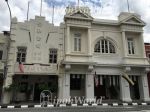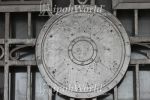We've tried to ensure the information displayed here is as accurate as possible. Should there be any inaccuracies, we would be grateful if you could let us know at info@ipohworld.org . All images and content are copyright.
(Please click on the thumbnail for a bigger image.)
Bastianpillai Paul Nicholas And The Bank Of Malaya Ltd




The Bank of Malaya Limited was founded by Bastianpillai Paul Nicholas, a man of foresight and strong principles. He came to Malaya from Ceylon as a young man in 1892 travelling from Ceylon to Penang by sailing boat and then on to Klang (Port Swettenham) in Selangor. He received his early education in Singapore and was employed in various Malayan states with the Federal Engineering Company becoming the accountant of the Penang branch. The photograph of B P Nicholas (top left), as he preferred to be called, together with much of the text, was provided by our donor via the family website https://www.antonnicholas.org.uk/profiles/oriental.htm/
B P Nicholas, the only ethnic Tamil ever to obtain a Banking Licence un Malaya, was an entrepreneur driven by a strategic vision and who, single-handedly, overcame major hurdles and colonial power to found his bank.
Initially he entered into business with a close friend, Mr Kock, a contractor in Ipoh and then, between the years of 1918 and 1920 started his first (money lending) business, providing personal financial services in Ipoh, thus effectively becoming one of the early Asian bankers in the history of British Colonial Malaya.
This led to the establishment, in 1920, of B P Nicholas and Sons, who’s Head Office was at No 2 Foch Avenue, (Now Jalan Cheng Lock) Kuala Lumpur.
In 1936 he succeeded in obtaining a Colonial License to open the Bank of Malaya Ltd. An illustrious title for such an enterprise by a foreigner! The bank was incorporated on December 31 1936 with its head office at Mountbatten Road, Kuala Lumpur and Branches/Agencies in Colombo, Jaffna, Klang, Seremban and Ipoh. The bank was capitalised at $180,000 and the Bank of Malaya Limited held its first meeting on January 9, 1937.
The main proportion of the business was limited to handling remittances by the members of the Ceylonese community working in Malaya, who gave the bank their firm and solid support. He later acquired the Bank of Jaffna in Sri Lanka in 1938.
In its second year of operation, the Bank of Malaya actually reported a net profit of $16,085.
In late 1938, the bank was advised by the government to change its name to the Oriental Bank of Malaya Limited. The reason, we are told, was that the British banks were unhappy over the use of the name as it lifted up the profile of the real status of the bank and the original name helped attract business, not only from the Tamil community but also from some established local businessmen.
On Saturday 4 August 1940, The Straits Times reported:
“MR. B. P. NICHOLAS. MR. B. P. Nicholas of Kuala Lumpur, managing director of the Oriental Bank of Malaya, Ltd., of Kuala Lumpur, Klang, and Ceylon, and a director of the bank of Jaffna (Malaya) Ltd., of Seremban, accompanied by Mrs. Nicolas left Kuala Lumpur foe Singapore en-route to Ceylon.”
We have no record of when they returned to Malaya.
The Japanese Occupation of Malaya affected so many families and businesses. Initially the Oriental Bank was closed by the Japanese, but allowed to reopen on 28 August 1842. Shortly afterwards, on 20th October 1942, the visionary B P Nicholas passed away. His eldest son Edwin, who was a young maturing man in his thirties and had been a director since 1936, was appointed chairman. As the founder was not on the scene, the bank had to operate on a reduced scale and Edwin trained all his young brothers. Albert, Cyril, Alfred and Victor then assisted in the operation of the bank. But chaos followed the Japanese surrender and the banking business had to be suspended - it officially recommenced on September 15, 1945.
The family continued to run the business successfully through many troubled years, but in 1968 a Malaysian-born entrepreneur, Cho Jock Kim, Managing Director of the Far Eastern Hotel Development Company (FEHD), approached the family and offered $1-60 a share to buy out the family’s controlling 52% share. Consequently, in 1969, the vision of B P Nicholas who founded the one-time ‘Nicholas Bank’, as it was popularly known among older clients, came to an end.
Nonetheless the Oriental Bank continued in business, with Cho as the majority shareholder, but it us recorded that he sold some shares to UMBC amongst others. In 1978 he was charged with CBT on five charges. Lawyers representing Oriental Bank held a watching brief throughout the trial. It was alleged that out id $5million paid to FEHD, the company only received $2million. Additional charges totalled $24.2million, of which on $5milliom was paid to his company. The trial was lengthy and complicated involving Pernas UMBC, Oriental Bank and FEHD. Found guilty, Cho was jailed for seven years on 28 July 1978. He was 46 years old.
Subsequently the building was taken over by the Oversea Chinese Banking Corporation (OCBC). It is not clear whether this was a merger or a takeover as this is not included in any history texts we have searched so far. However, with the decline in the tin mining industry, it was not long before the Straits Trading Building was bought over to houses the Ipoh main branch of OCBC and the grand old Bank of Malaya building in Hugh Low Street, (Now Jalan Sultan Iskandar), was left empty.
It remained so for more than 20 years until it was bought and renovated by our second donor, Lim Chai Hock, and transformed into a hotel named “Sarang Paloh” with the banking hall on ground floor becoming an Event Hall. The original staircase and fittings remain intact. An air raid shelter was constructed in the centre of the garden area either before or during the Japanese Occupation. The new owners have kept this as a feature of the hotel. The façade windows still have the original bars of the first bank and the second photograph of the hotel shows the facade although the bronze medallion on each side cannot be clearly seem. These medallions carry the name "Bank of Malaya". One of these can be seen in the third photograph above.
Finally a scan of a 1937 advertisement for the Bank of Malaya Limited is included above for information.
To see a procession passing the Oversea Chinese Bank (OCBC) in Hugh Low Street, click here.